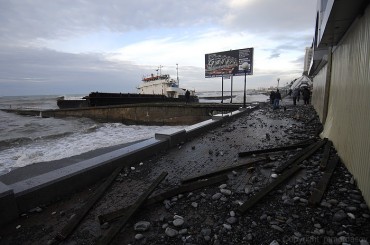The marketing tidal wave is taking the planet by storm. The Olympic Games are all the media talk about these days, and it’s easy to understand why. The cocktail is perfect: human performance on a daily basis, glory, patriotism, and just the right amount of scandal. This huge quadrennial event is going to be remembered for a long time, and partly because of its astronomical cost. Vladimir Putin’s forecast of 12 billion American dollars in 2007 was grossly underestimated. The latest calculations announce a colossal final bill of 50 billion. By comparison, the previous winter games in Vancouver in 2010 cost a little over 8 billion US dollars.
 These Olympic Games have the merit to put the spotlight on the Black Sea and more particularly on the region of Sochi in North Caucasia. On the same latitude as the Côte d’Azur in France, this part of Russia is appreciated for its subtropical climate. During the Stalin era, it naturally became destination of choice for the ruling classes.
These Olympic Games have the merit to put the spotlight on the Black Sea and more particularly on the region of Sochi in North Caucasia. On the same latitude as the Côte d’Azur in France, this part of Russia is appreciated for its subtropical climate. During the Stalin era, it naturally became destination of choice for the ruling classes.
Prior to 2007 Sochi was a peaceful little summer town which looked after its beachfront and palm trees. Not exactly the type of winter resort you’d expect to win the Olympic race. But during the International Olympic Committee Session in Guatemala in 2007, the destiny of the resort town was changed forever.
To host the very first Winter Olympic Games of Russia, everything had to be built from scratch as the infrastructure for winter sports was virtually non-existent. The Olympic villages, stadiums, roads, railways, an airport, hotels etc… This pharaonic project was so vast, the amount of material needed so large, that it was necessary to build a cargo port in Adler next to the Olympic site, just a few kilometres from the Georgian border.
The problem is that this part of the Black Sea’s coast doesn’t offer any natural shelter from the elements. A breakwater was constructed, but according to the brilliant ARTE documentary “Putin’s games”, the retaining pillars weren’t planted deep enough in the ocean floor.
 When a classic Black Sea storm hit the coast in autumn 2009, with gale-force winds and waves reaching 9 meters according to witnesses, the half built port didn’t stand a chance. The devastation was almost total, and the investors found themselves with a new port to build, and nowhere to bring in the materials for the Olympic Games’ infrastructures.
When a classic Black Sea storm hit the coast in autumn 2009, with gale-force winds and waves reaching 9 meters according to witnesses, the half built port didn’t stand a chance. The devastation was almost total, and the investors found themselves with a new port to build, and nowhere to bring in the materials for the Olympic Games’ infrastructures.
In 2012, as the port of Adler was finally completed, it was too late. All the material had already been channelled via a rapidly constructed railway, and the brand new docks proved to be expensively useless, even though it is planned to convert the cargo docks into a yacht marina once the games are finished.
The 2009 storm is an example of one of the characteristics that make the Black Sea so remarkable. It is a dangerous sea to navigate because of its shape and the total absence of offshore protection – only 10 small islands are disseminated on it. Even its name doesn’t really inspire sympathy, and historians are still arguing today on its origin. One theory refers to the colour of the Black Sea’s deep waters during winter and its heavy fogs.
This body of water of 422’000 km2 could be the only place on Earth where wooden wrecks from the Antiquity can still be studied. The scientific reason for this is called “anoxic marine system”, which is a barbaric way to say that the oxygen levels of the water are very low. There is very little mixing between the upper and the lower layers of the Black Sea, preventing the penetration of oxygen. Below a depth of 200 meters this anaerobic environment prevents the survival of typical wood-devouring organisms creating a natural museum.
In more recent history, the Danube Delta, on the Ukrainian-Romanian shore of the Black Sea, has been inscribed on the UNESCO World Heritage list. It is the acknowledgment that the most vast and best persevered European delta is a biosphere worth protecting.
But although its uniqueness is recognised worldwide, the ecology of the Black Sea is under a lot of pressure. In 2008, the European Council issued an alarming report, predicting an ecological disaster if nothing was done to control the over-fishing and the dumping of high quantities of toxic wastes coming from the 6 surrounding countries that are Romania, Ukraine, Russia, Georgia, Turkey and Bulgaria. With only one connection to the Mediterranean via the Bosphorus, the toxicity levels can only rise.
Once the Olympic buzz fades, and the spotlights move on, the Black Sea will most probably return to its dark fate.
